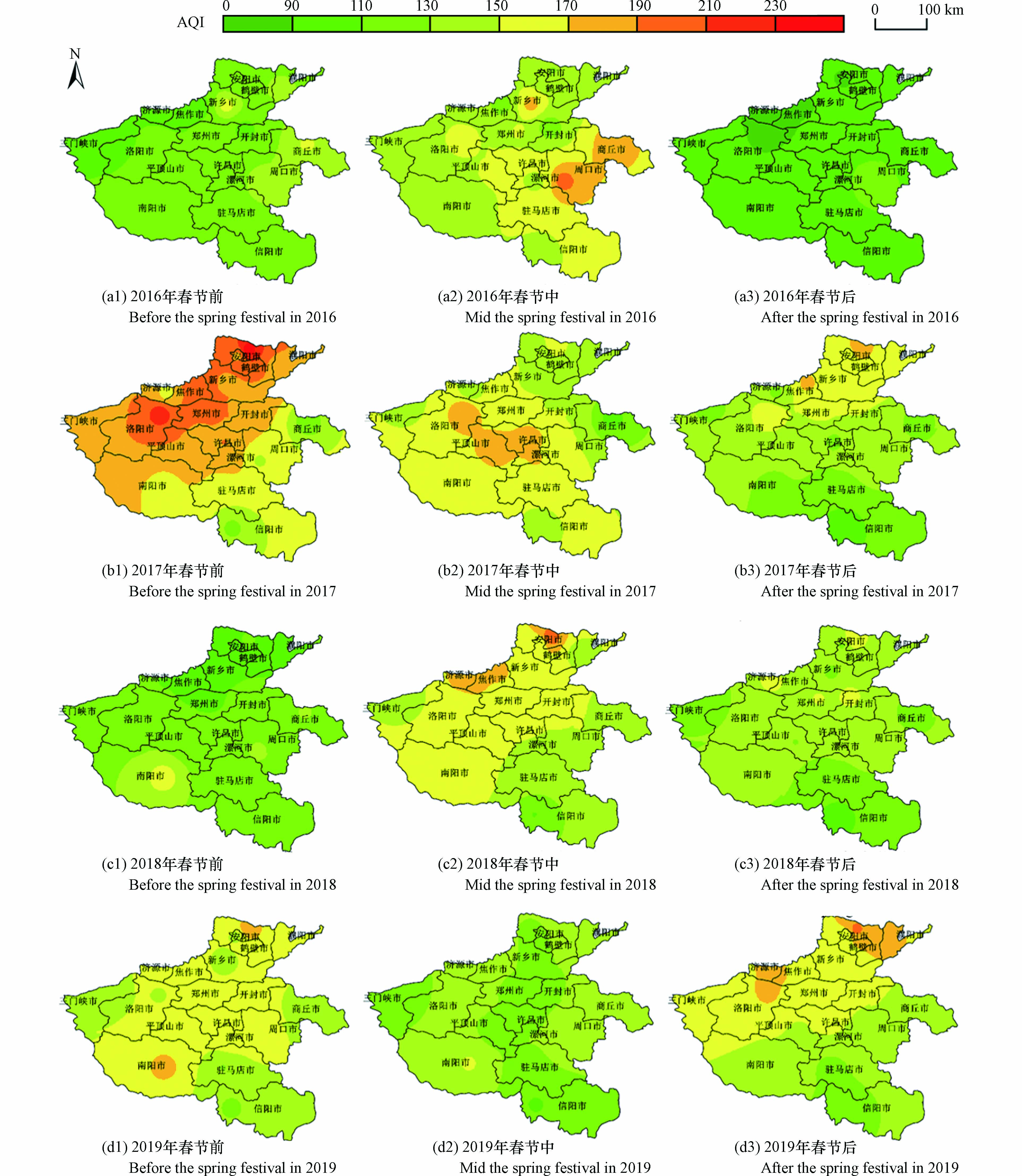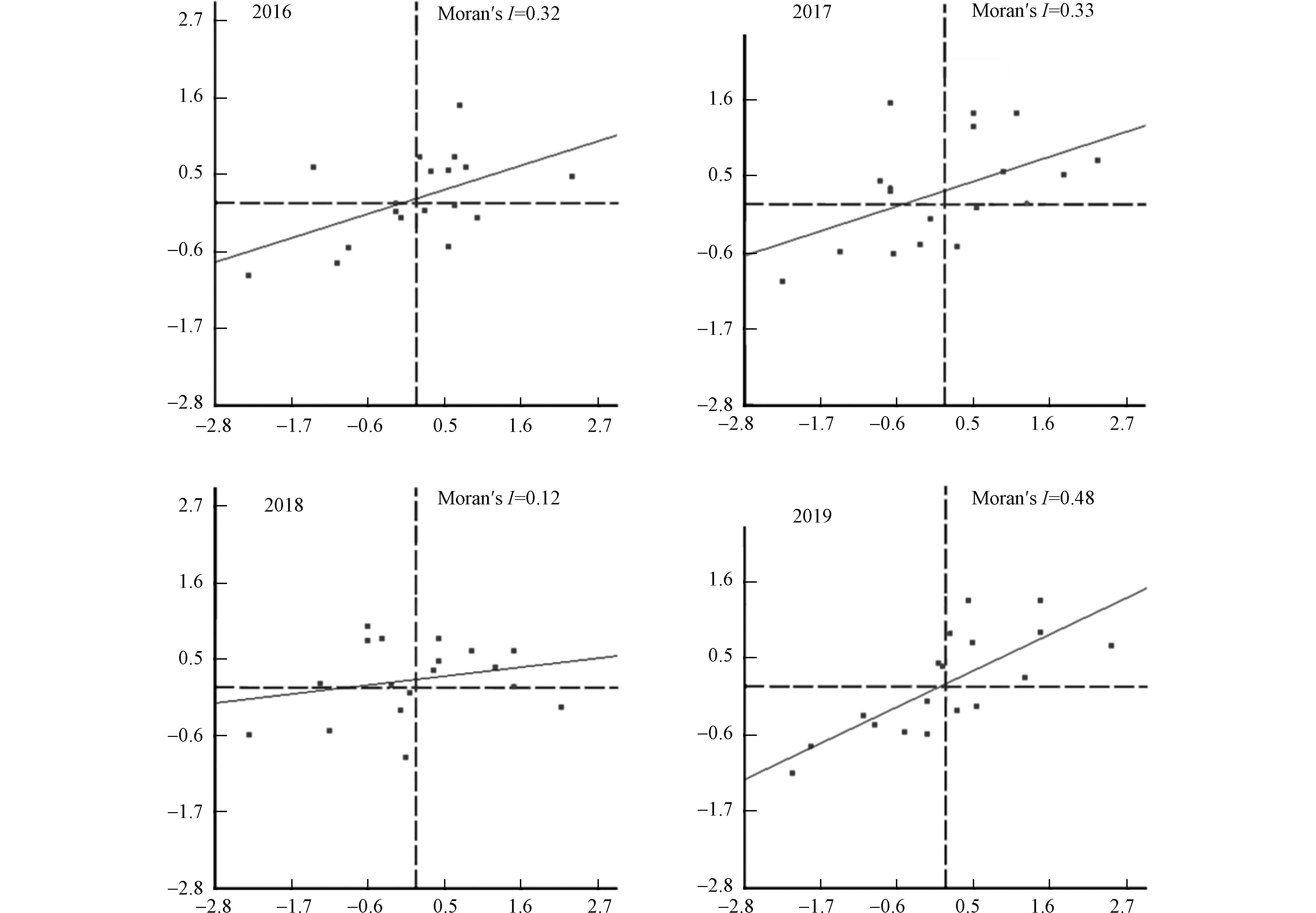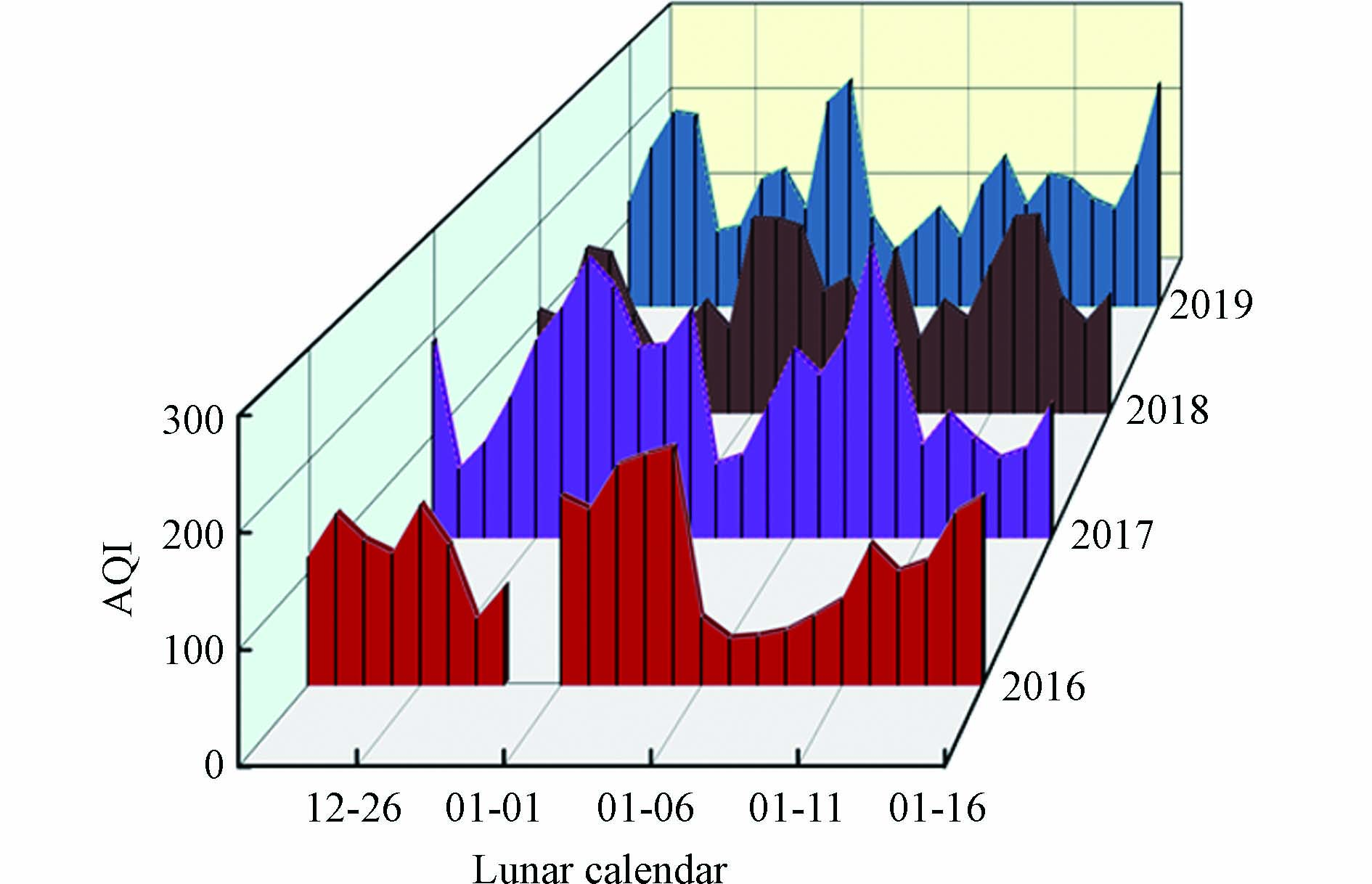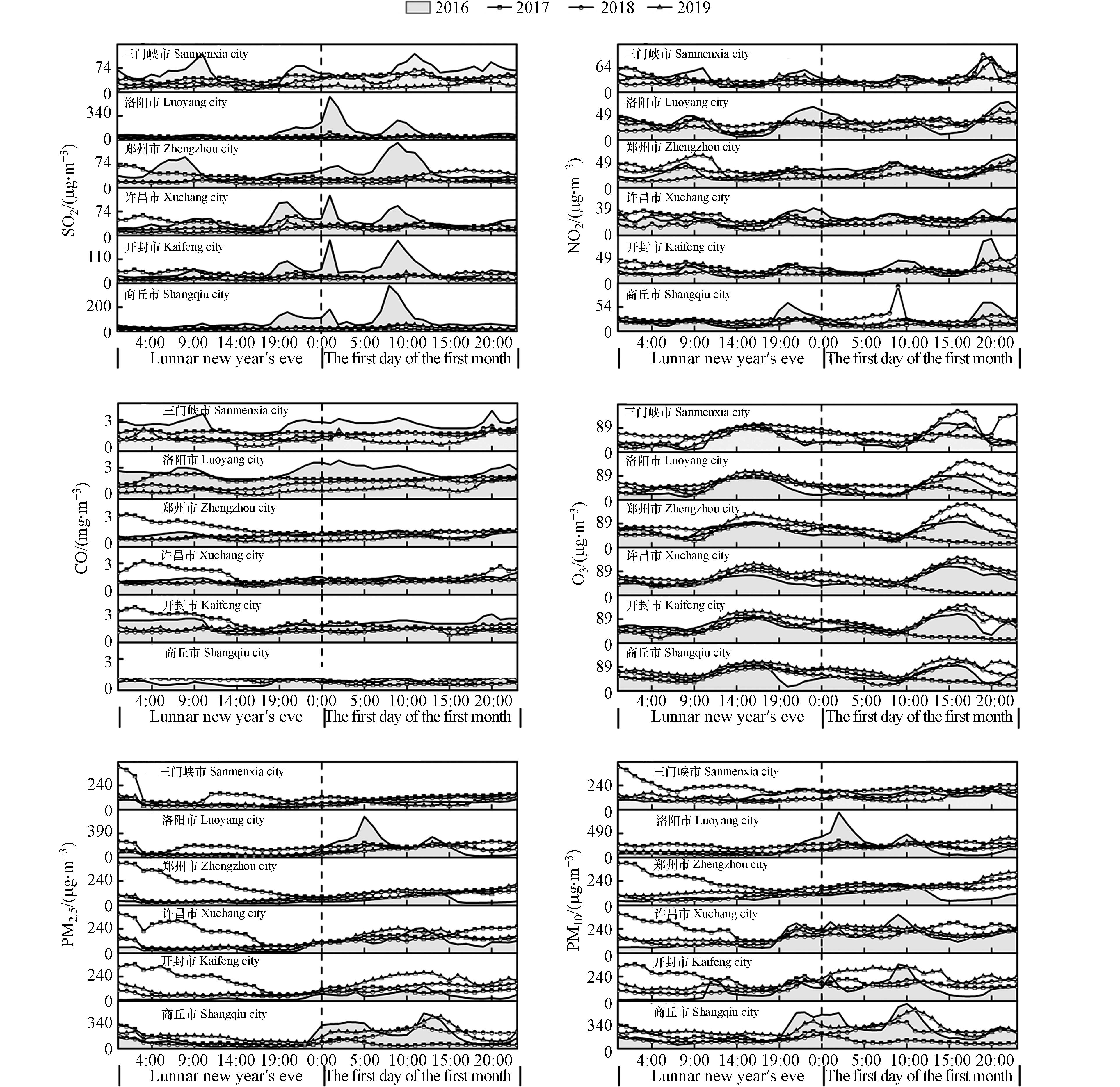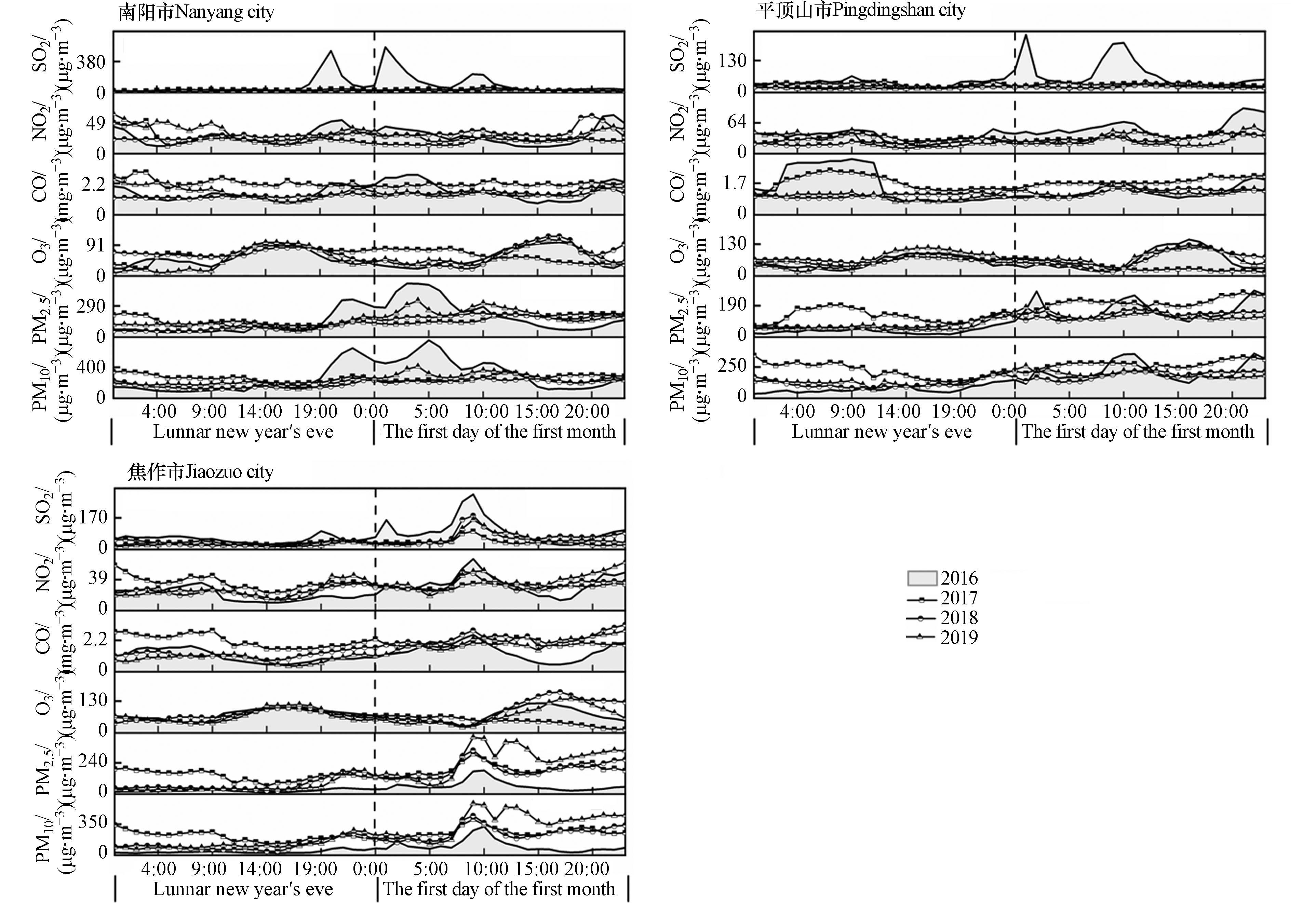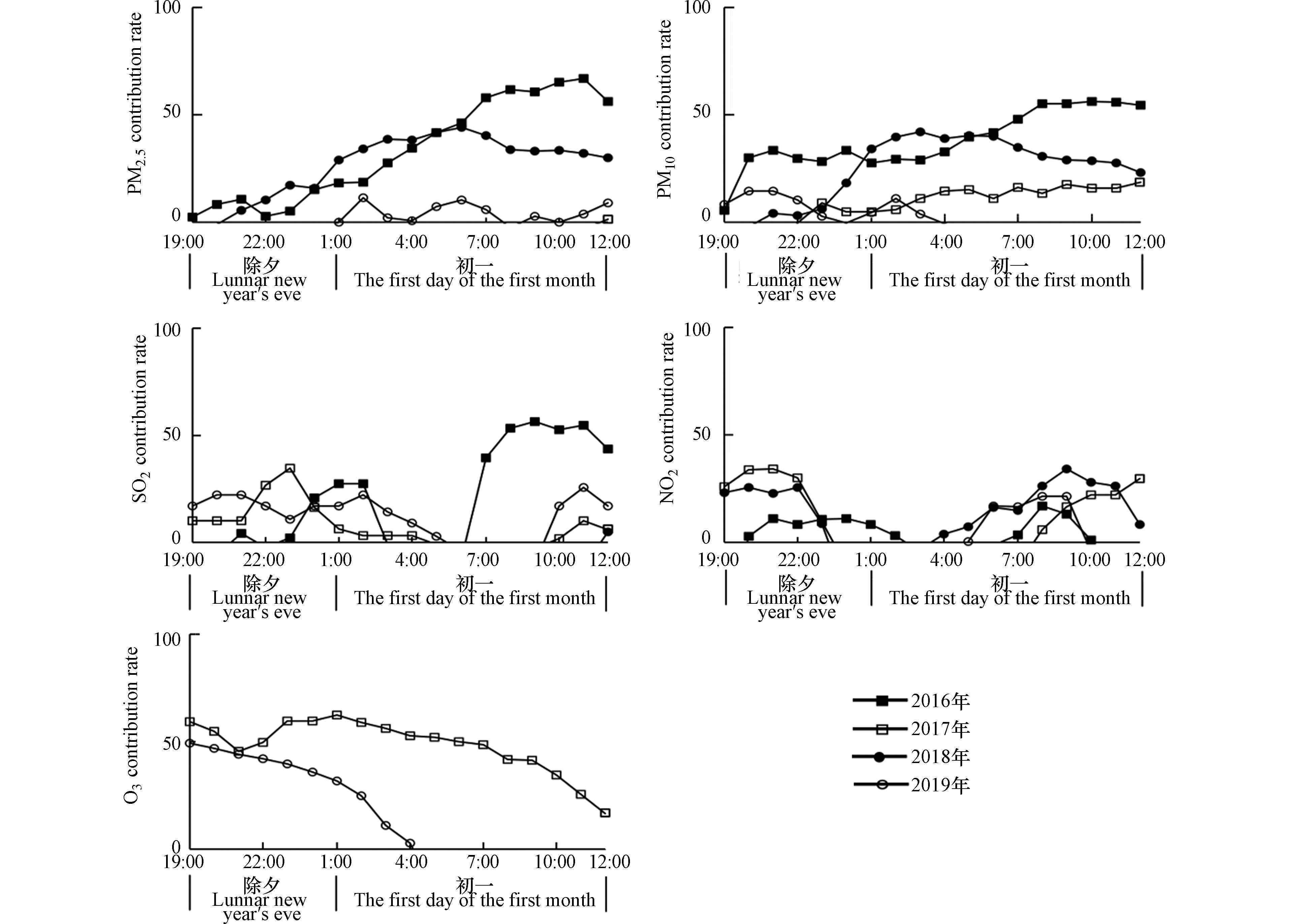-
工业时代以来,大气污染就成为全球最为关注的环境问题之一[1]。大气污染不仅阻碍区域经济的发展,而且对生态环境和居民健康产生各种负面影响[2]。高浓度的大气污染物对人体各类器官产生不良影响[3],导致呼吸道、心血管等病症[1],甚至引发癌症等重型疾病[4],每年全球都会有大量人员因此死亡[5]。尽管近年来空气质量有明显改善的趋势,但短期内空气迅速恶化的事件却时有发生,其中,以传统节日期间燃放烟花爆竹所引起的大气污染物浓度骤升现象最为频繁,且影响范围广大。相较于工业和交通等污染源的持续性与稳定性[1,4,6],燃放烟花爆竹所造成的污染具有短时效性、间断性和集中性[7]。实际上,用烟花爆竹庆祝大型节日活动在世界范围内普遍存在,如:印度的迪帕瓦里节[8]、伊朗的察哈尔—山贝苏里文化节[2]、荷兰的新年之夜[5,9-11]、美国的独立日庆典[12-14]、马尔他群岛[15]和意大利[16]的节日庆祝活动等。因此,学术界对其关注度也越来越高[7,17-20]。
烟花爆竹作为中国庆祝春节的传统习俗已经延续了一千多年[21-23],河南作为中华民族起源与繁荣发展的核心区域,烟花爆竹的燃放历史更是悠久绵长,也是目前典型的烟花爆竹燃放区。爆竹的主要成分是黑火药[30],包含硫磺粉(S)、硝酸钾(KNO3)、木炭粉(C),有的还包含氯酸钾(KClO3),制作烟花时还要加入无机盐和镁粉(Mg)等[13, 30-32]。因此,烟花爆竹的大量燃放会导致SO2等气态污染物和PM等颗粒污染物[33]、重金属[18]及有毒物质[34]等的浓度在短期内迅速上升。近些年来,为了解决春节期间的大气污染问题,政府接连出台了一系列禁燃、禁放、禁售政策,也逐渐得到了居民的认可[21]。关于节日期间烟花爆竹燃放引起的短期大气污染事件,学术界同样进行了深入研究。就国外而言,印度排灯节期间[24-25]大规模烟花活动导致空气质量在短期内迅速恶化,PM颗粒污染物和SO2、NO等气态污染物浓度骤升;荷兰新年期间[9-11],颗粒物和气溶胶的浓度显著升高,还发现烟花事件、PM10浓度和每日死亡率之间存在一定的正相关关系;美国圣诞节[13]和独立日[14]烟花燃放量的升高致使PM2.5和PM10浓度显著高于节日前。我国关于烟花爆竹燃放与空气污染的研究,主要集中在北京[7,26]、南京[6,27]、上海[28]、武汉[29]、成都[30]、广州[31]、海口[32]、石家庄和郑州[21]等省会城市[33],研究内容主要涉及烟花爆竹燃放引起的人体健康和居民安全问题、大气颗粒污染物和主要化学成分的浓度变化、春节前中后不同时期的空气质量变化、烟花燃放是否受到监管的城市之间空气质量的对比分析等。
综上可见,已有研究主要集中在两个方面:在没有禁燃的背景下,探究燃放烟花爆竹对某一孤立城市整体的大气环境质量、污染物浓度及居民健康的影响;在有明确或较为模糊的烟花管控措施下,针对不同城市之间政策的差异性而进行的污染物浓度对比研究。关于传统烟花燃放区,尤其是同一城市或城市群内部,禁燃政策实施前后的对比分析及其实施成效是否显著进行定量化剖析的研究相对较少;另外,已有研究几乎没有考虑由于城市地理位置不同导致的气象条件差异,从而忽视了由此引起的城市空气质量和污染物浓度的差异性。这些不足之处导致了部分公众对政府禁燃政策的适用性看法不一,目前的研究结果也尚不足以彻底打消公众的疑虑,从上而下的政策监管转变为自下而上自觉拥护仍需要一定的时间。
本研究以典型烟花燃放区河南省18个地市2016—2019年逐小时的空气质量指数(AQI)、污染物浓度和气象因子监测数据为基础,分析河南省禁燃政策实施前后春节前、中、后期的空气质量变化特征,并将烟花爆竹对大气污染物的贡献定量化,对实施禁燃政策的成效进行探析,以期为是否有必要在春节期间实施禁燃政策或更进一步加强禁燃力度、扩大禁燃范围的科学决策提供依据。
-
河南省界于110°21'E—116°39'E,31°23N—36°22'N之间(图1),地势自西向东逐渐下降,太行山、伏牛山、桐柏山和大别山沿河南省边界于北、西、南三面呈半环形分布,大气扩散条件较差,易出现静风和逆温现象,不利于污染物的迁移、扩散。河南省18个地市不仅是中原城市群的主体城市,还是京津冀及周边“2+26”城市中的重要交通枢纽,与中部崛起、黄河流域生态保护和高质量发展、“一带一路”建设等重大国家战略的有效实施密切相关。
-
空气质量指数和污染物(PM2.5、PM10、NO2、SO2、O3、CO)质量浓度数据来源于2016—2019年河南省各地市环境监测中心自动监测站,为全年24 h连续监测数据。气象因子数据来自河南省18个地市地面气象观测站,为全年逐时观测数据,包括温度、气压、相对湿度、风速和降水。AQI是用于定量描述空气质量状况的无量纲指数[34],根据其值范围分为6个等级:0—50(优)、51—100(良)、101—150(轻度污染)、151—200(中度污染)、201—300(重度污染)以及>300(严重污染)。
数据的计算方法参照《环境空气质量标准》(GB3095—2012)和《环境空气质量指数(AQI)技术规定》[34-35]。根据前人研究[8,18,36-37]和中国传统习俗所处的特殊日期[27,30],如小年(腊月二十三)、除夕[29]、正月初一、元宵节[38](正月十五)将春节分为前、中、后期[39]。春节前期为腊月二十二至腊月二十九(8 d)、春节中期为除夕至正月初七(8 d)、春节后期为正月初八至正月十六(9 d)。
-
距离倒数权重(inverse distance weight , IDW)插值法是将散点数据面状化最常用的方法之一。其公式为:
式中,Zi为已知点I的Z值;Zj为未知点J的估计值;xi、yi为已知点I的坐标;xj、yj为未知点J的坐标;s是已知点的数量;k是确定的幂值,控制局部影响的程度。
-
空间自相关能直观地反映空间邻近单元的相似度,揭示污染物变化的时空分布格局。全局Moran's I用于分析在整个研究区内空气质量指数是否存在集聚或离散特征的分布模式。局部Moran's I可以度量区域内是否存在高值或低值的局域空间集聚。表达式为:
式中,n为城市站点的总数;xi、xj为分别为i站点和j站点的AQI。
$ \stackrel{-}{\mathit{x}} $ 为区域AQI的算术平均值。Wij为空间权重矩阵。 -
欧氏距离是衡量多维空间中各个点之间的绝对距离,在计算相似度的场景下,是比较直观、常见的相似度算法。结合前人研究[18,40],采用欧氏距离原理,将算法进一步改进, 并赋予相应权重,得到相似性指数S。表达式为:
式中,Wi、Wj、Wk和Wl分别为气温、风速、气压和相对湿度的权重。TEMx和TEMy分别为某一年的温度值;WDx和WDy分别为某一年的风速值;PRSx和PRSy分别为某一年的气压值;RHVx和RHVy分别为某一年的相对湿度。
-
总体来看,2016—2019年河南省春节中期AQI呈逐渐降低的趋势(图2)。其中,2016年春节中期平均AQI明显高于春节前期和后期,且在周口、商丘等东部地区呈现出明显的高值区;春节前期AQI高值区主要位于新乡、商丘和周口等地,随着春节庆典活动到来,烟花爆竹燃放量逐渐攀升,到了春节中期这些地区的AQI率先成为高值区;到了春节后期,随着烟花爆竹燃放量的减少,各地AQI均明显降低。2017年河南省整体空气质量较2016年污染严重。AQI变化呈春节前期到春节后期逐渐下降的趋势,春节前期高值区主要位于安阳、洛阳、焦作等传统重工业区及经济活动密集区;春节中期上述高污染地区的AQI大幅降低,到春节后期全省AQI继续下降。2018年春节前、中、后期的空气质量较2017年均得到了明显的改善。春节前期基本上不存在AQI污染区,春节中期AQI高值区出现在安阳、济源、焦作等北部地区,到春节后期,空气质量整体转好。2019年春节中期AQI明显低于春节前期和后期,是近4年来同期的最低值,但春节前期和后期的AQI较2018年有所增加。
为了揭示河南省各城市之间的AQI空间分布是否存在集聚特征,利用空间自相关方法进行了逐年分析,分别得出全局和局部Moran's I(表1)。从表1可以看出,2017年春节后期、2018年前期和2019年后期P值均小于显著水平0.01,Z得分超过了临界值2.58,达到了99%的置信度,表明河南省各地级市的AQI在空间上呈现出一定的集聚特征。
根据2016—2019年春节期间空气质量浓度的局部Moran's I散点图(图3)可以看出,4个年份HH区(重污染区与重污染区集聚)的数量都为7,并没有发生数量变化,说明4年间河南省重污染区分布相对较为集中,并没有新增离散地区;LH区(轻度污染区环绕重污染区)呈先增后减的趋势,由2016年的1个增至2017的4个和2018年的5个,2019年又降至1个;HL区(重污染区包围轻度污染区)呈下降趋势,由2016年的6个降至2019年的2个;LL区(轻度污染区与轻度污染区集聚)的数量逐年增加,由2016年的4个升至2019年的7个。污染物高值区逐渐向低值区转换及HL区的减少和LL区的增多,间接体现了不同城市之间的污染物通道传输作用,表明了河南省18个城市之间空气质量的相互作用机制。
-
从2016—2019年河南省春节时期的AQI日均值(图4)可以看出,AQI高值区出现的时间稍有提前。2016年AQI高值主要集中在正月初一至初五,达到中度污染水平;春节后期AQI持续降低,至正月初七达到最小值,为42;接着于正月十六达到第二峰值,为169。2017年春节前、中、后期AQI呈逐级递减的趋势,高值期稍有提前,出现在腊月二十六至二十九,腊月二十八达到峰值(273);正月初三至正月初五传统高峰期空气质量严峻形势呈弱化趋势,AQI值于正月初三降低至最小值(72),继而升高,于正月初九达到高值(285),正月十六再次降低至131。2018年春节中期的AQI达到4年来同期的最高水平(155),而在传统高值时期较低,除夕和正月十六分别为91和125。2019年春节中期的AQI在4年同期中处于最低值,且明显优于春节前期和后期。这与伊朗德黑兰地区在庆祝活动后的AQI变化趋势是一致的,该地区的AQI在庆祝活动之后的夜间上升到200以上[2]。同时对春节前、中、后期的AQI与各气象因子之间的相关关系进行分析,发现春节前期相对湿度与AQI的相关性最强,春节中期和后期则分别是气温和降水与AQI关系密切。但气象因子与AQI的相关系数在年际间的变幅并不明显。可见,气象因子并不是同时期春节空气质量显著变化的主要原因,而春节期间的烟花活动可能是造成短期AQI变化的主要原因。
-
为打赢大气污染攻坚战,河南省于2017年开始实施一系列措施[41],要求县级及以上城市建成区全时段禁止销售、燃放烟花爆竹,以防出现春节期间污染物浓度骤升、大面积爆表的现象(表2)。2018年,该政策通过扩大范围和增大强度得到了进一步加强,全省各地级市主城区均全时段禁燃。2019年8月,河南省再次加强禁燃力度,相继出台全域全时段烟花爆竹禁售禁放的政策规定[21]。
-
纬度差异会造成城市内部太阳辐射和气象条件的差异,进而对污染物的产生、扩散及迁移产生影响。为了减弱上述影响,选择同属于暖温带大陆性季风气候,且位于同一纬度带(34°N—35°N之间)的城市,包括三门峡、洛阳、郑州、开封、商丘和许昌(图1)。通过对该6个城市2016—2019年除夕至正月初一逐小时污染物浓度变化趋势进行分析(图5),评估禁燃政策的实施成效。
在年际尺度上,6个城市连续4年间SO2浓度均呈波动变化,且2016年高于其他年份,禁燃政策实施后的3年间SO2浓度年际差异较小,呈逐年下降的趋势,可见禁燃政策的实施对SO2浓度有“削峰”作用。在年间尺度上,从2016年除夕19:00烟花爆竹大量燃放开始,6个城市SO2浓度均呈波动上升趋势,于正月初一的2:00达到峰值(烟花燃放基本停滞),5:00逐渐降低至谷值;第二峰值则出现在正月初一的7:00—11:00,12:00之后逐渐降低。这一特征与印度艾哈迈达巴德市排灯节晚上至次日凌晨SO2浓度的变化趋势一致[18]。
除夕至正月初一期间6个城市4年间NO2的变化趋势接近,且变化幅度较小,可见同时期的烟花燃放可能不是其主要污染源。这一结果与Garg等[36]的研究相一致。6个城市NO2的峰值和高值区集中出现在9:00和20:00,这主要受到居民出行早、晚高峰的影响,再加上春节期间人流量及车流量剧增,使得NO2排放量在短时间内达到峰值[42]。CO的高值区主要在除夕0:00—9:00和初一20:00之后。其中,三门峡和洛阳禁燃政策实施后CO浓度较2016年降低;而郑州、开封和商丘在2017年除夕凌晨,CO浓度高于2016年同时期,在其他时间相差不大,且变化幅度和变化速率均较小。O3浓度没有明显的年际变化,均呈现午后上升、夜间下降的趋势。在年间尺度上,O3浓度变化呈“双峰”趋势,即9:00开始上升,14:00—15:00达到峰值,接着开始下降,6:00—7:00达到最小值。这与安阳[43]和郑州[44]的O3日变化分析结果相似。O3浓度变化主要与光化学反应有关,与烟花爆竹燃放的关系不密切。
烟花爆竹燃放是春节期间颗粒污染物PM2.5和PM10的重要来源[37],其突变上升值大多位于集中燃放时间。禁燃对洛阳和商丘颗粒污染物浓度降低的成效尤为明显,尤其在除夕19:00至初一的2:00这个烟花爆竹集中燃放的时段,2017—2019年期间的峰值较2016年明显降低,且高峰期持续时间也明显缩短。
综上可见,禁燃对SO2、PM2.5和PM10的影响最为明显,这与伊朗德黑兰地区的研究结果相一致[2]。对NO2和O3来说,禁燃成效并不明显,这与意大利米兰的研究结果相近[16],4年间其浓度变化趋势没有明显的突变值,且变化幅度和浓度范围也均大致相近。禁燃对CO浓度的降低有一定的成效,但对于部分城市效果并不明显,可能与当地禁燃政策实施的强度和禁燃范围、禁燃时间有一定的关系,尚需进一步研究。
-
经度不同也会引起城市内部污染物传输、扩散及迁移,为减弱这种影响,选择河南省同一经度地带(114°E—115°E之间)的6个城市,分别为安阳、鹤壁、开封、周口、驻马店和信阳(图1),开展禁燃政策实施成效分析(图6)。
由图6可见,安阳和鹤壁污染物浓度变化趋势及峰值出现的时刻相近,2017—2019年SO2浓度明显低于2016年,且除夕24:00后出现的两个峰值于正月初一均未出现,表明禁燃对两市SO2浓度降低效果明显。除夕至正月初一期间安阳和鹤壁的NO2、O3和CO浓度并未出现2016年原有峰值的消失,可见禁燃对其影响不明显。禁燃对两市的颗粒污染物有一定的影响,2016年正月初一1:00的PM2.5和PM10峰值及3:00的PM10峰值在2017—2019年均未出现,但正月初一8:00附近的峰值连续4年均未消失,其原因有待进一步探究。
开封、周口、驻马店和信阳4市污染物浓度变化特征较为相似。开封和周口2016年除夕至初一SO2浓度变化呈三峰趋势,驻马店和信阳呈双峰趋势,而到了2017—2019年这些峰值均不再凸显。除夕至初一禁燃对周口和信阳NO2浓度有一定的“削峰”作用,尤其是对两市2016年除夕21:00出现的NO2峰值削减更为明显。禁燃对4市O3和CO浓度的影响不明显,2017—2019年浓度与2016年基本持平。禁燃对PM2.5和PM10影响较为明显,表现最为突出的是除夕19:00至正月初一10:00,该时间段2016年出现的峰值被削低,2017—2019年变化特征趋于平缓,达到浓度高值区的时间明显延缓。
-
对河南省各地市同时期气象因子的相似程度进行分析(表3),取相似程度最高的6个城市(南阳、信阳、洛阳、平顶山、鹤壁和焦作),探究在相似气象要素条件下禁燃对污染物浓度的影响(图7)。其中,信阳、洛阳和鹤壁前文已述,因此该部分不再赘述。
从图7可见,南阳、焦作和平顶山3市污染物浓度变化特征基本接近,峰值出现的时间和频率大致吻合,SO2、PM2.5和PM10的变化趋势与禁燃的响应最好,尤其是在烟花爆竹大量燃放期,即除夕19:00至正月初一凌晨1:00。NO2浓度的变化与禁燃呈弱相关或不相关,2017—2019年的浓度变化趋势与2016年相比差异较小,变化幅度也较小。O3和CO浓度变化与禁燃之间的关系也不显著,4年间的变化特征并没有随着禁燃政策的实施、禁燃力度的加强和禁燃范围的扩大而发生明显变化。
-
为了定量评估河南省禁燃政策的实施成效,参考前人研究[31,41,45],结合河南省大气污染特征,将烟花爆竹燃放对污染物浓度的贡献进行定量化。采用相对比值法,从与烟花燃放关系并不显著的NO2、O3和CO中选取参考指标。由于NO2易受春节车流量和过境量增加等人为因素影响,O3易受到太阳辐射和温度等自然因素的影响,在光照条件下由NO2等前体物质转变而成,故不能作为参考指标。CO与烟花燃放响应既不显著,又不易受自然和人为因素影响,故可以作为参考指标来定量评估烟花燃放对污染物浓度的贡献,方法如下[21,28]:
式中,Mfw为燃放烟花爆竹对污染物的贡献量,M为实测浓度,Mnfw为污染物估算浓度,CO为实测浓度,(M/CO)nfw为非燃放时段污染物M与CO平均浓度的比值。根据燃放习俗,规定除夕19:00至正月初一11:00为集中燃放时段,除夕0:00至19:00,正月初一11:00至24:00为非燃放时段。
利用2016—2019年河南省18个地市除夕至正月初一全时段、集中燃放时段和非集中燃放时段污染物浓度进行变异系数测算(表4),结果显示,3个时段中CO的标准差最小,且其在集中燃放时段最小,说明CO的浓度变化在集中燃放期波动较小,进一步验证了烟花爆竹对CO浓度贡献较小,采用其作为参考指标来估算污染物浓度具有参考价值;NO2、O3和CO的变异系数较小且较为接近,说明其在传统春节期间变化幅度较小,变化趋势稳定,烟花爆竹对其浓度变化影响不显著。
选取交通密集型、传统庆典活动盛大区郑州市来定量探究烟花爆竹燃放对污染物浓度的贡献率和持续贡献时间(图8)。从图8可以看出,2016年是烟花爆竹对PM2.5、PM10和SO2贡献率和贡献时间最大的一年,贡献率分别在初一的11:00、10:00和9:00达到峰值,分别为66.98%、56.32%和56.49%,贡献持续时间分别为18 h、18 h和11 h。2017年禁燃政策初步实施即取得了一定的成效,较2016年集中燃放时段烟花对污染物浓度的贡献量明显降低,对PM2.5、PM10和SO2贡献率分别为26.55%、6.64%和6.85%。随着禁燃力度的加强和禁燃范围进一步扩大,2018年和2019年烟花对上述3类污染物浓度的贡献量进一步降低,到2019年烟花对PM2.5、PM10和SO2最大贡献率分别降至11.54%、14.52%和25.71%,分别位于初一2:00、除夕21:00和初一10:00,平均贡献率分别为−0.63%、−0.23%和9.05%,持续贡献时间分别为11 h、8 h和14 h。烟花对NO2和O3的贡献率变化幅度并不明显,表明烟花并不是春节期间NO2和O3的主要来源,这也与烟花爆竹的成分燃烧所产生的污染物类型有关。
-
基于河南省18个地市2016—2019年逐小时空气质量、污染物浓度和气象因子数据,在分析区域内整体的空气质量时空变化的基础上,探讨禁燃政策的实施成效,并将烟花爆竹对各污染物的贡献率和贡献时间进行定量化。
(1)2016—2019年河南省春节中期的空气质量呈现逐渐改良的趋势,且高值区出现的时间稍有提前,省内城市间表现为污染物高值区逐渐向低值区转换及高低集聚区减少和低低集聚区增多的特点,说明邻近城市的污染物传输通道作用在一定程度上也影响着空气质量。
(2)禁燃政策的实施对SO2、PM2.5和PM10的影响最为明显,在除夕至正月初一的污染物浓度短期骤升现象减少,呈现出 “削峰”作用;对NO2、O3、CO的影响较小,即烟花爆竹燃放不是引起春节期间其污染的主要原因,而是由燃放产生的污染物类型决定的。
(3)2016年是烟花爆竹对污染物浓度贡献量最大、贡献持续时间最长的一年,对SO2、PM2.5和PM10贡献率分别于初一11:00、10:00和9:00达到峰值,分别为66.98%、56.32%和56.49%,持续时间分别为18 h、18 h和11 h。到2019年,烟花爆竹对PM2.5、PM10和SO2最大贡献率分别降至11.54%、14.52%和25.71%,分别在初一2:00、除夕21:00和初一10:00。
河南省春节禁燃政策对大气污染的影响分析
Analysis of effect of burning ban policy on air pollution during the Spring Festival in Henan Province
-
摘要: 烟花爆竹的燃放是短期内空气质量恶化的重要原因,严重危害人体健康。利用河南省18个地市2016—2019年空气质量指数、污染物浓度(SO2、NO2、O3、CO、PM2.5和PM10)和气象因子(气压、气温、相对湿度、风速、降水)数据,采用距离倒数权重插值、变异系数分析及相似性指数等方法,从多角度探究河南省春节禁燃政策的实施成效。结果表明,2016—2019年河南省春节期间的空气质量呈现逐渐改良趋势,污染出现的时间稍有提前,多出现在春节前期。禁燃对控制SO2、PM2.5和PM10的浓度骤升(“削峰”)有很好的效果,对NO2、O3、CO的影响较小。2016年烟花爆竹燃放对PM2.5、PM10和SO2贡献量最大、贡献时间持续最长,贡献率分别为66.98%、56.32%和56.49%;到2019年,随着禁燃成效的逐步显现,烟花对PM2.5、PM10和SO2的最大贡献率分别降至11.54%、14.52%和25.71%。Abstract: Pollutants generated by fireworks and firecrackers caused the deterioration of air quality in the short term, which seriously endangers human health. Based on the data of air quality index (AQI), pollutants concentrations (SO2, NO2, O3, CO, PM2.5 and PM10) and meteorological factors (pressure, temperature, relative humidity, wind speed, precipitation) in 18 cities of Henan Province from 2016 to 2019, this paper analyzes effectiveness of the burning ban policy on controlling the air quality and air pollutants during the Spring Festival in Henan Province by using the methods of inverse distance weight, coefficient of variation analysis and similarity index. The results showed that the air quality showed a gradual improvement trend, and the air pollution occurred slightly earlier, mostly in the early part of the Spring Festival after fireworks and firecrackers being forbidden. Burning ban has a good effect on controlling the sudden rise (“peak clipping”) of SO2, PM2.5 and PM10, but has a poor effect on NO2, O3 and CO. The discharge of fireworks and firecrackers contributed the most and the contribution lasted the longest to PM2.5, PM10 and SO2, with the decreases of 66.98%, 56.32%, 56.49%, respectively. Burning ban in 2019 resulted PM2.5, PM10 and SO2 reducing by 11.54%, 14.52%, 25.71%, respectively.
-

-
表 1 2016—2019年河南省春节不同时期AQI空间自相关分析
Table 1. Spatial autocorrelation analysis of AQI during different periods of the Spring Festival in Henan Province from 2016 to 2019
2016 2017 2018 2019 前期
Early中期
Mid后期
Late前期
Early中期
Mid后期
Late前期
Early中期
Mid后期
Late前期
Early中期
Mid后期
LateMoran's I −0.15 −0.12 0.12 0.16 0.13 0.34 0.30 0.02 0.04 −0.15 −0.12 0.33 Z −0.63 −0.45 1.28 1.57 1.35 2.84 2.62 0.58 0.73 −0.63 −0.45 2.76 P 0.53 0.65 0.20 0.12 0.18 0.00 0.01 0.56 0.47 0.53 0.65 0.01 表 2 2016—2019年春季期间河南省烟花爆竹禁燃政策变化
Table 2. Changes in the ban on fireworks and firecrackers during the Spring Festival in Henan Province from 2016 to 2019
2016 2017 2018 2019 安阳 无 市主城区及龙安腊梅园示范区 维持 扩大 濮阳 无 市主城区 扩大 维持 鹤壁 无 市主城区 扩大 维持 新乡 无 市建成区 扩大 扩大 焦作 无 市建成区 维持 维持 济源 无 市区1环路内 扩大 维持 郑州 无 市5区、4个开发区 扩大 维持 开封 无 市主城区 维持 扩大 商丘 无 市主城区 扩大 扩大 洛阳 无 市建成区限放 扩大、升级 维持 三门峡 无 市主城区 维持 扩大 平顶山 无 市4个开发区 扩大 维持 许昌 无 市主城区 维持 扩大 漯河 无 市主城区 维持 扩大 周口 无 市主城区 维持 扩大 驻马店 无 市主城区 维持 扩大 南阳 无 市主城区 维持 扩大 信阳 无 市主城区 维持 扩大 注:“无”表示未施行禁燃政策;“维持”表示禁燃政策所规定的禁燃范围保持不变;“扩大”表示禁燃政策所规定的禁燃范围扩大至市主城区及县(区)建成区;“升级”表示禁燃政策由限放升级为禁放.
Note: “None”: the burning ban policy has not been implemented. “Maintain”: the range of ban on burning under the burning ban policy remains unchanged; “Expanded”: the burning ban range stipulated by the burning ban policy is extended to the main urban areas and counties of the city (Area) built-up area; “upgrade”: the burning ban policy has been upgraded from restricted discharge to no discharge.表 3 2016—2019年河南省各气象因子相似系数分布表
Table 3. Correlation coefficients of various meteorological factors in Henan Province from 2016 to 2019
排名
Rank城市
City相似系数
Similarity coefficient排名
Rank城市
City相似系数
Similarity coefficient1 南阳市 0.680 10 周口市 0.728 2 信阳市 0.708 11 郑州市 0.732 3 洛阳市 0.709 12 开封市 0.736 4 平顶山市 0.717 13 漯河市 0.743 5 鹤壁市 0.720 14 商丘市 0.745 6 焦作市 0.721 15 许昌市 0.750 7 驻马店市 0.722 16 三门峡市 0.758 8 新乡市 0.724 17 安阳市 0.765 9 濮阳市 0.726 18 济源市 0.774 表 4 2016—2019年河南省春节期间不同时段污染物变异系数分析
Table 4. Analysis for the coefficient of variation of pollutants during different periods of the Spring Festival in Henan Province from 2016 to 2019
SO2/(μg·m−3) NO2/(μg·m−3) CO/(mg·m−3) O3/(μg·m−3) PM2.5/(μg·m−3) PM10/(μg·m−3) 全时段平均值 41.38 28.29 1.53 63.06 120.97 182.77 集中燃放时段平均值 58.03 28.58 1.52 54.58 148.92 220.89 非集中燃放时段平均值 32.25 28.12 1.54 67.71 105.65 161.86 全时段标准差 46.66 12.31 0.70 29.12 87.05 103.09 集中燃放时段标准差 69.35 11.22 0.65 19.20 91.10 108.98 非集中燃放时段标准差 22.33 12.86 0.72 32.40 80.75 93.34 全时段变异系数 1.13 0.44 0.45 0.46 0.72 0.56 集中燃放时段变异系数 1.20 0.39 0.42 0.35 0.61 0.49 非集中燃放时段变异系数 0.69 0.46 0.47 0.48 0.76 0.58 -
[1] YANG M, FAN H, ZHAO K. Fine-grained spatiotemporal analysis of the impact of restricting factories, motor vehicles, and fireworks on air pollution [J]. International Journal of Environmental Research and Public Health, 2020, 17(13): 4828. doi: 10.3390/ijerph17134828 [2] OROJI B, SADIGHZADEH A, SOLGI E. Effects of fireworks ancient celebrations on atmospheric concentration of particulate matter in Iran [J]. Geology, Ecology, and Landscapes, 2020, 4(2): 104-110. doi: 10.1080/24749508.2019.1600909 [3] TANDA S, LIČBINSKÝ R, HEGROVÁ J, et al. Impact of New Year's Eve fireworks on the size resolved element distributions in airborne particles [J]. Environment International, 2019, 128: 371-378. doi: 10.1016/j.envint.2019.04.071 [4] XU Y L, LIU Z Y, XUE W B, et al. Identification of on-road vehicle CO2 emission pattern in China: A study based on a high-resolution emission inventory [J]. Resources, Conservation and Recycling, 2021, 175: 105891. doi: 10.1016/j.resconrec.2021.105891 [5] WARNER J. Enschede cries - Restoring ontological security after a fireworks disaster [J]. International Journal of Disaster Risk Reduction, 2021, 59: 102171. doi: 10.1016/j.ijdrr.2021.102171 [6] KONG S F, LI X X, LI L, et al. Variation of polycyclic aromatic hydrocarbons in atmospheric PM2.5 during winter haze period around 2014 Chinese Spring Festival at Nanjing: Insights of source changes, air mass direction and firework particle injection [J]. Science of the Total Environment, 2015, 520: 59-72. doi: 10.1016/j.scitotenv.2015.03.001 [7] LAI Y H, BRIMBLECOMBE P. Changes in air pollution and attitude to fireworks in Beijing [J]. Atmospheric Environment, 2020, 231: 117549. doi: 10.1016/j.atmosenv.2020.117549 [8] MAHILANG M, DEB M K, NIRMALKAR J, et al. Influence of fireworks emission on aerosol aging process at lower troposphere and associated health risks in an urban region of eastern central India [J]. Atmospheric Pollution Research, 2020, 11(7): 1127-1141. doi: 10.1016/j.apr.2020.04.009 [9] GREVEN F E, VONK J M, FISCHER P, et al. Air pollution during New Year's fireworks and daily mortality in the Netherlands [J]. Scientific Reports, 2019, 9: 5735. doi: 10.1038/s41598-019-42080-6 [10] TEN BRINK H, OTJES R, WEIJERS E. Extreme levels and chemistry of PM from the consumer fireworks in the Netherlands [J]. Atmospheric Environment, 2019, 212: 36-40. doi: 10.1016/j.atmosenv.2019.04.046 [11] TEN BRINK H, HENZING B, OTJES R, et al. Visibility in the Netherlands during New Year's fireworks: The role of soot and salty aerosol products [J]. Atmospheric Environment, 2018, 173: 289-294. doi: 10.1016/j.atmosenv.2017.11.020 [12] JIA C R, XUE Z Q, FU X Q, et al. Impacts of Independence Day fireworks on pollution levels of atmospheric polycyclic aromatic hydrocarbons (PAHs) in the US [J]. Science of the Total Environment, 2020, 743: 140774. doi: 10.1016/j.scitotenv.2020.140774 [13] HOYOS C D, HERRERA-MEJÍA L, ROLDÁN-HENAO N, et al. Effects of fireworks on particulate matter concentration in a narrow valley: The case of the Medellín metropolitan area [J]. Environmental Monitoring and Assessment, 2019, 192(1): 6. [14] SEIDEL D J, BIRNBAUM A N. Effects of Independence Day fireworks on atmospheric concentrations of fine particulate matter in the United States [J]. Atmospheric Environment, 2015, 115: 192-198. doi: 10.1016/j.atmosenv.2015.05.065 [15] CAMILLERI R, VELLA A J. Effect of fireworks on ambient air quality in Malta [J]. Atmospheric Environment, 2010, 44(35): 4521-4527. doi: 10.1016/j.atmosenv.2010.07.057 [16] VECCHI R, BERNARDONI V, CRICCHIO D, et al. The impact of fireworks on airborne particles [J]. Atmospheric Environment, 2008, 42(6): 1121-1132. doi: 10.1016/j.atmosenv.2007.10.047 [17] ZHANG J M, YANG L X, CHEN J M, et al. Influence of fireworks displays on the chemical characteristics of PM2.5 in rural and suburban areas in Central and East China [J]. Science of the Total Environment, 2017, 578: 476-484. doi: 10.1016/j.scitotenv.2016.10.212 [18] CHHABRA A, TURAKHIA T, SHARMA S, et al. Environmental impacts of fireworks on aerosol characteristics and radiative properties over a mega city, India [J]. City and Environment Interactions, 2020, 7: 100049. doi: 10.1016/j.cacint.2020.100049 [19] GOUDER C, MONTEFORT S. Potential impact of fireworks on respiratory health [J]. Lung India:Official Organ of Indian Chest Society, 2014, 31(4): 375-379. doi: 10.4103/0970-2113.142124 [20] FIEDRICH M, KURTENBACH R, WIESEN P, et al. Artificial O3 formation during fireworks [J]. Atmospheric Environment, 2017, 165: 57-61. doi: 10.1016/j.atmosenv.2017.06.028 [21] PANG N N, GAO J, ZHAO P S, et al. The impact of fireworks control on air quality in four Northern Chinese cities during the Spring Festival [J]. Atmospheric Environment, 2021, 244: 117958. doi: 10.1016/j.atmosenv.2020.117958 [22] ZHANG X C, SHEN H F, LI T W, et al. The effects of fireworks discharge on atmospheric PM 2.5 concentration in the Chinese lunar new year [J]. International Journal of Environmental Research and Public Health, 2020, 17(24): 9333. doi: 10.3390/ijerph17249333 [23] YUAN L, ZHANG X L, FENG M, et al. Size-resolved hygroscopic behaviour and mixing state of submicron aerosols in a megacity of the Sichuan Basin during pollution and fireworks episodes [J]. Atmospheric Environment, 2020, 226: 117393. doi: 10.1016/j.atmosenv.2020.117393 [24] Shivani, GADI R, SAXENA M, et al. Short-term degradation of air quality during major firework events in Delhi, India [J]. Meteorology and Atmospheric Physics, 2019, 131(4): 753-764. doi: 10.1007/s00703-018-0602-9 [25] JOSHI M, NAKHWA A, KHANDARE P, et al. Simultaneous measurements of mass, chemical compositional and number characteristics of aerosol particles emitted during fireworks [J]. Atmospheric Environment, 2019, 217: 116925. doi: 10.1016/j.atmosenv.2019.116925 [26] 张章, 刘保献, 安欣欣, 等. 北京市传统春节假期空气质量特征研究 [J]. 中国环境科学, 2021, 41(1): 102-113. doi: 10.3969/j.issn.1000-6923.2021.01.012 ZHANG Z, LIU B X, AN X X, et al. A study on the air quality in Beijing during the Spring Festival [J]. China Environmental Science, 2021, 41(1): 102-113(in Chinese). doi: 10.3969/j.issn.1000-6923.2021.01.012
[27] KONG S F, LI L, LI X X, et al. The impacts of firework burning at the Chinese Spring Festival on air quality: Insights of tracers, source evolution and aging processes [J]. Atmospheric Chemistry and Physics, 2015, 15(4): 2167-2184. doi: 10.5194/acp-15-2167-2015 [28] YAO L, WANG D F, FU Q Y, et al. The effects of firework regulation on air quality and public health during the Chinese Spring Festival from 2013 to 2017 in a Chinese megacity [J]. Environment International, 2019, 126: 96-106. doi: 10.1016/j.envint.2019.01.037 [29] HAN G, GONG W, QUAN J H, et al. Spatial and temporal distributions of contaminants emitted because of Chinese New Year's Eve celebrations in Wuhan [J]. Environmental Science. Processes & Impacts, 2014, 16(4): 916-923. [30] WU K Y, DUAN M, LIU H F, et al. Characterizing the composition and evolution of firework-related components in air aerosols during the Spring Festival [J]. Environmental Geochemistry and Health, 2018, 40(6): 2761-2771. doi: 10.1007/s10653-018-0141-9 [31] 裴成磊, 王宇骏, 毕燕茹, 等. 广州市2020年春节期间烟花爆竹燃放对空气质量的影响 [J]. 环境科学, 2021, 42(2): 546-555. PEI C L, WANG Y J, BI Y R, et al. Influence of burning fireworks on the atmosphere during the spring festival in Guangzhou in 2020 [J]. Environmental Science, 2021, 42(2): 546-555(in Chinese).
[32] 徐文帅, 吴晓晨, 陈蕊, 等. 春节期间烟花爆竹燃放对海口市空气质量的影响 [J]. 中国环境监测, 2020, 36(5): 104-111. XU W S, WU X C, CHEN R, et al. Influence of burning fireworks on air quality during the spring festival in Haikou City [J]. Environmental Monitoring in China, 2020, 36(5): 104-111(in Chinese).
[33] LAI Y H, BRIMBLECOMBE P. Regulatory effects on particulate pollution in the early hours of Chinese New Year, 2015 [J]. Environmental Monitoring and Assessment, 2017, 189(9): 467. doi: 10.1007/s10661-017-6167-0 [34] 赵晴, 李岩岩, 贺克斌, 等. 2019年元宵节重污染期间济宁市PM2.5化学组分特征及污染成因分析 [J]. 环境化学, 2020, 39(4): 900-910. doi: 10.7524/j.issn.0254-6108.2019090902 ZHAO Q, LI Y Y, HE K B, et al. Analysis of PM2.5 chemical characteristics and causes during heavy pollution in Jining City around the Lantern Festival of 2019 [J]. Environmental Chemistry, 2020, 39(4): 900-910(in Chinese). doi: 10.7524/j.issn.0254-6108.2019090902
[35] 张向敏, 罗燊, 李星明, 等. 中国空气质量时空变化特征 [J]. 地理科学, 2020, 40(2): 190-199. ZHANG X M, LUO S, LI X M, et al. Spatio-temporal variation features of air quality in China [J]. Scientia Geographica Sinica, 2020, 40(2): 190-199(in Chinese).
[36] GARG A, GUPTA N C. Short-term variability on particulate and gaseous emissions induced by fireworks during Diwali celebrations for two successive years in outdoor air of an urban area in Delhi, India [J]. SN Applied Sciences, 2020, 2(12): 1-14. [37] SINGH A K, SRIVASTAVA A. The impact of fireworks emissions on air quality in Delhi, India [J]. Environmental Claims Journal, 2020, 32(4): 289-309. doi: 10.1080/10406026.2020.1756078 [38] CHANG S C, LIN T H, YOUNG C Y, et al. The impact of ground-level fireworks (13km long) display on the air quality during the traditional Yanshui Lantern Festival in Taiwan [J]. Environmental Monitoring and Assessment, 2011, 172(1/2/3/4): 463-479. [39] HU T P, MAO Y, LIU W J, et al. Fate of PM2.5-bound PAHs in Xiangyang, central China during 2018 Chinese spring festival: Influence of fireworks burning and air-mass transport [J]. Journal of Environmental Sciences, 2020, 97: 1-10. doi: 10.1016/j.jes.2020.04.011 [40] CT R, NISHANTH T, MK S, et al. Temporal changes in air quality during a festival season in kannur, India [J]. Atmosphere, 2019, 10(3): 137. doi: 10.3390/atmos10030137 [41] 胡丙鑫, 段菁春, 刘世杰, 等. 2018年春节期间京津冀及周边地区烟花禁放效果评估 [J]. 环境科学研究, 2019, 32(2): 203-211. HU B X, DUAN J C, LIU S J, et al. Evaluation of the effect of fireworks prohibition in the Beijing-Tianjin-Hebei and surrounding areas during the spring festival of 2018 [J]. Research of Environmental Sciences, 2019, 32(2): 203-211(in Chinese).
[42] 贾佳, 丛怡, 高清敏, 等. 中原城市冬季两次重污染形成机制及来源 [J]. 环境科学, 2020, 41(12): 5256-5266. JIA J, CONG Y, GAO Q M, et al. Formation mechanism and source analysis of two heavy pollution periods in winter in a central Plains City [J]. Environmental Science, 2020, 41(12): 5256-5266(in Chinese).
[43] 杨健, 尹沙沙, 于世杰, 等. 安阳市近地面臭氧污染特征及气象影响因素分析 [J]. 环境科学, 2020, 41(1): 115-124. YANG J, YIN S S, YU S J, et al. Characteristic of surface ozone and meteorological parameters analysis in Anyang City [J]. Environmental Science, 2020, 41(1): 115-124(in Chinese).
[44] 王旭东, 尹沙沙, 杨健, 等. 郑州市臭氧污染变化特征、气象影响及输送源分析 [J]. 环境科学, 2021, 42(2): 604-615. WANG X D, YIN S S, YANG J, et al. Characteristics, meteorological influences, and transport source of ozone pollution in Zhengzhou City [J]. Environmental Science, 2021, 42(2): 604-615(in Chinese).
[45] 吕文丽, 张凯, 曹晴, 等. 烟花爆竹燃放对大气污染物及PM2.5组分影响 [J]. 中国环境科学, 2020, 40(8): 3303-3311. doi: 10.3969/j.issn.1000-6923.2020.08.007 LÜ W L, ZHANG K, CAO Q, et al. Impacts of fireworks burning on atmospheric pollutants and water-soluble inorganic ions in PM2.5 [J]. China Environmental Science, 2020, 40(8): 3303-3311(in Chinese). doi: 10.3969/j.issn.1000-6923.2020.08.007
-



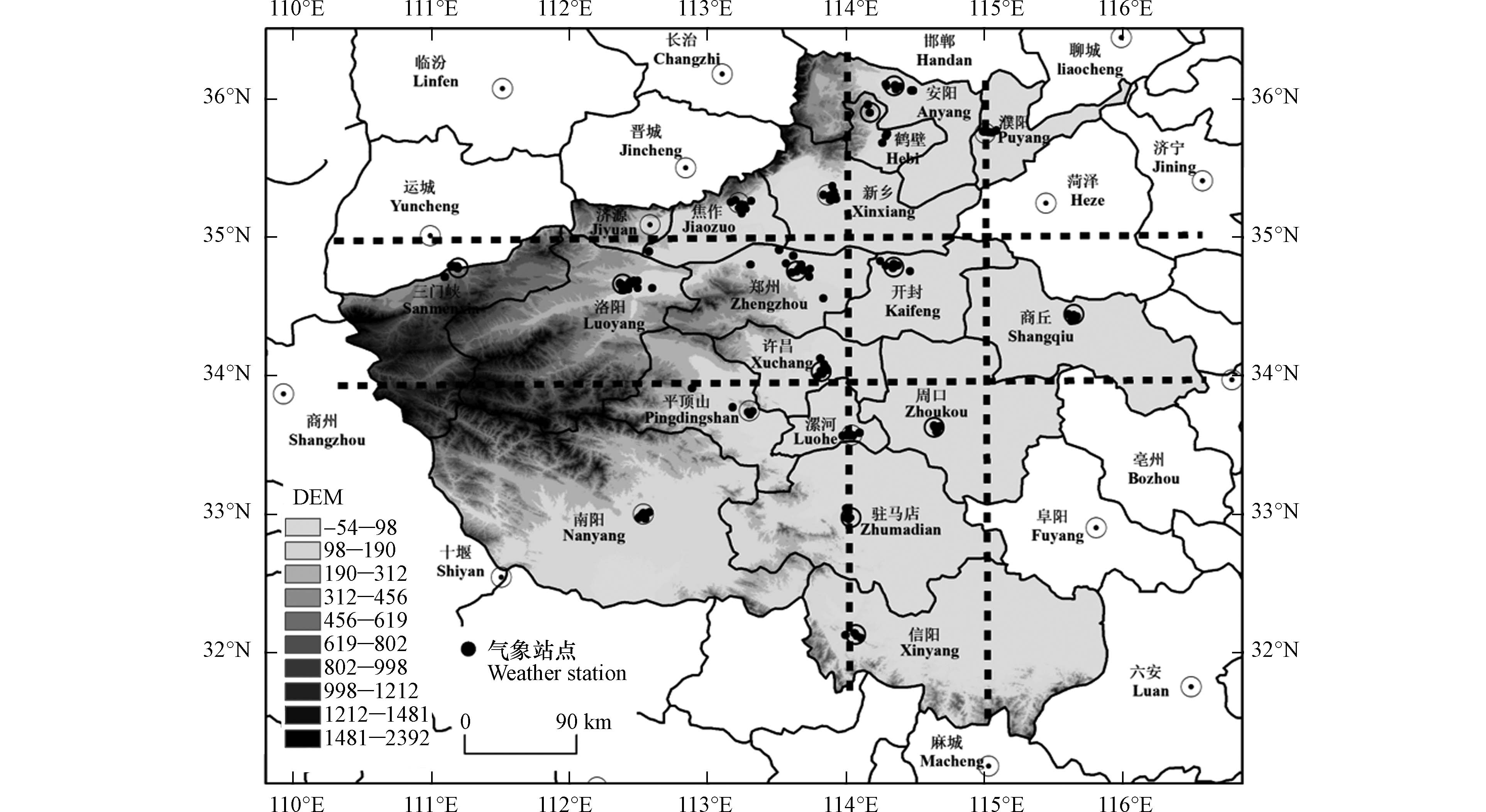
 下载:
下载:
